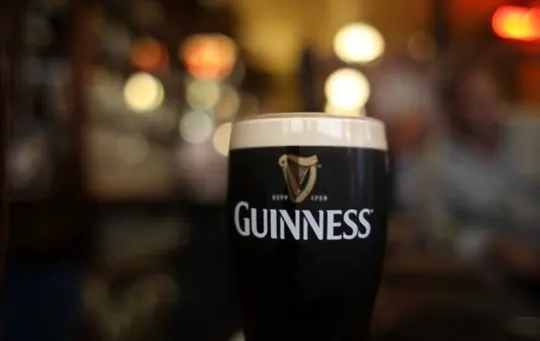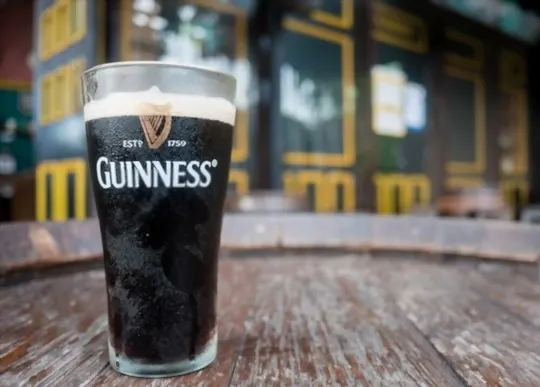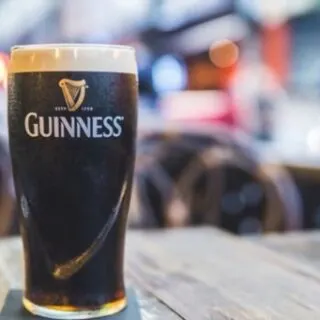Everyone loves a good pint of beer, and if you’re in the UK or Ireland than Guinness is an undisputed staple.
But what does it actually taste like?
Many have tried to answer this question over the years with mixed results.
Some say it’s smoky and malty in flavor, while others describe its profile as roasty and fruity.
To help settle once-and-for-all this perplexing debate, we’ve put together a comprehensive guide that dives deep into what exactly makes up Guinness’ unique taste.
Here, you’ll discover not only how they make their beloved dark stout but also why people love it so much that its become one of the most popular beers around!
What is Guinness?

Guinness is a popular Irish dry stout that was first introduced in Dublin, Ireland, in 1759.
It has since become one of the most famous beers worldwide and is enjoyed by beer enthusiasts all over the world.
The beer gets its name from Arthur Guinness, the founder of the brewery where it was first made.
Guinness is famously dark and thick with a creamy head, which sets it apart from other types of beer.
The beer is often described as rich and hearty, with a robust flavor that can be both sweet and bitter.
It has an alcohol content of about 4.
2%, making it relatively mild compared to some other types of beer.
Guinness is brewed using a combination of high-quality malted barley, hops, yeast, and water.
The brewing process involves roasting the barley to give it a distinctive flavor and color.
This results in a beer that has a unique taste profile that is loved by many.
If you’re wondering what makes Guinness so special, it’s mainly down to its unique roasting technique during the brewing process.
This gives the beer its characteristic dark color and ensures that it stays fresh for longer than other beers.
Additionally, Guinness is infused with nitrogen when poured to give it its classic creamy head and smooth texture.
What Does Guinness Taste Like?

Guinness is a unique beer that has its own distinct taste.
The beer is known for having a creamy texture and a dark color, which immediately distinguishes it from other types of beer.
The flavor of Guinness is rich and complex, with notes of coffee, chocolate, and roasted malt coming through in each sip.
If you love the taste of coffee or chocolate, you will likely enjoy the taste of Guinness.
As you take a sip of Guinness, you’ll immediately notice the silky smooth texture of the beer on your tongue.
Unlike many other types of beer that can be rough or fizzy, Guinness glides effortlessly across your taste buds.
As you savor the flavor, you’ll pick up on hints of bitterness that are balanced out by sweet notes.
One thing that makes Guinness special is its nitrogenation process.
Unlike most beers that are carbonated with CO2, Guinness is infused with nitrogen to give it a unique micro-bubble creamy head.
This adds to the texture and overall drinking experience as it makes the flavors more pronounced on the palate.
Overall, the flavor of Guinness can be described as robust and full-bodied.
It’s not overpowering or heavy but rather easy to drink while still being packed full of interesting flavors.
Ingredients That Affect the Taste of Guinness
Guinness is known for its distinctive taste, which comes from a combination of various ingredients used in its brewing process.
Here are three main ingredients that affect the taste of Guinness:
When it comes to tasting Guinness, you can expect a complex yet balanced flavor profile.
The roasted grains give it a satisfying bitterness with notes of coffee and chocolate, while the hops provide floral and earthy undertones.
Overall, it has a smooth mouthfeel with just enough carbonation.
1 – Malt
Malt is an important ingredient that affects the taste of Guinness.
It is a type of cereal grain that has been germinated and dried.
The malt used in Guinness is specially roasted barley, which adds to its distinctive dark color and complex flavor profile.
- The degree of roasting affects the flavor and aroma of the malt. As barley is roasted, it undergoes chemical changes that produce flavors ranging from biscuity to coffee-like.
- The amount of malt used in a brew impacts its body and mouthfeel. Too little malt can result in a weak-tasting beer with a thin texture.
- Finally, the type of barley used also affects the quality of the malt. Different varieties have different levels of enzymes and sugar content, which influence how well they ferment and contribute to flavor development.
Using specially roasted barley malt gives Guinness its unique taste.
By roasting the barley at varying degrees, Guinness achieves a rich and complex flavor profile that includes hints of coffee, chocolate, caramel, and dark fruit notes.
The right amount and quality of malt are essential for creating Guinness’s creamy yet full-bodied texture.
Without enough malt or using low-quality varieties can result in a thin, watery beer lacking any complexity.
In short, malt plays an integral role in shaping Guinness’s signature taste by adding layers of depth through varying degrees of roasting and contributing to its full-bodied mouthfeel.
2 – Hops
Hops are an essential ingredient in creating the unique flavor and aroma of Guinness.
They are a type of flower that is grown on vines, typically in cool climates like Germany and the Pacific Northwest region of the United States.
Hops are responsible for balancing out the sweetness of the malt used in brewing and add flavorful bitterness to the beer.
In addition to adding flavor, hops also contain alpha acids which act as a natural preservative for beer.
This means that by incorporating hops into Guinness, it can extend its shelf life without relying on artificial preservatives.
The specific variety of hops used in Guinness is known as “fuggle.
” Fuggles have a low alpha acid content and impart a mild, earthy aroma to the beer.
The combination of fuggles with other hop varieties creates the iconic taste and aroma that Guinness is known for.
While many people think that hops are responsible for producing a bitter taste in beer, this is not entirely true.
The amount and type of hops used can vary greatly depending on the style of beer being brewed.
In Guinness, the use of hops complements rather than overpowers the malt flavors to create a balanced taste.
Overall, hops play an integral role in creating the distinct characteristics of Guinness.
From balancing sweetness to adding earthy aromas, this ingredient works alongside others like malt and yeast to craft one of Ireland’s most beloved beverages.
3 – Yeast
With regards to the brewing process of Guinness, the next important ingredient is yeast, which plays a critical role in determining the flavour profile of this iconic beer.
Yeast is a type of fungus that helps to ferment the sugars present in the wort and convert them into alcohol and carbon dioxide.
There are many different types of yeasts that can be used in brewing, each of which has its own unique characteristics.
For Guinness, a specific strain of yeast is used that has been carefully cultivated over many years to deliver the signature taste and aroma that consumers have come to love.
This yeast produces a mix of fruity and spicy flavours that blend together with notes of roasted barley and caramel to create a complex and satisfying drinking experience.
The fermentation process for Guinness typically takes several days, during which time the yeast works its magic on the wort while also producing additional compounds such as esters and phenols that contribute further to the overall flavour profile.
Overall, yeast is an essential ingredient in the brewing process, playing a crucial role in determining the final taste, aroma and character of any given beer.
For Guinness specifically, it is one of several factors that contribute to its distinctive and beloved flavour profile.
4 – Water
Water is the most important ingredient in Guinness.
In fact, it makes up more than 90% of the beer.
The water used to make Guinness comes from a natural spring located in the Wicklow mountains of Ireland.
The spring water is high in minerals such as calcium and magnesium which give extra flavor to the beer.
Since water is such an important part of making Guinness, it’s no surprise that they take great care in selecting and treating their water supply.
The water undergoes extensive filtration and treatment processes to ensure that it is free from impurities and has the right mineral content.
The quality of the water used in making Guinness also affects its texture and mouthfeel.
The mineral content of the water helps to create a smooth, creamy mouthfeel that is characteristic of Guinness.
In addition to using high-quality water, Guinness also uses a specific type of barley that is malted just for them.
This unique malted barley adds even more character to the beer and gives it a rich, roasted flavor.
So when you drink a pint of Guinness, be sure to appreciate not just its complex flavor but also the attention to detail that goes into each step of its brewing process.
How to Drink Guinness?

To drink Guinness, you first need to ensure it is properly poured.
A good bartender will pour your pint in two stages – first allowing the nitrogen gas to settle by pouring at a 45-degree angle and then topping up the glass at a 90-degree angle.
This creates the signature frothy head that Guinness is known for.
Once your pint has been properly poured, it’s time to take your first sip.
Don’t be put off by the thickness of the foam – this is part of what makes Guinness unique.
Take a small sip and let the beer roll around your mouth for a few seconds before swallowing.
This will allow you to fully appreciate the complex flavors of the beer.
As you continue drinking, pay attention to the texture of the beer – its thick, creamy mouthfeel is one of its defining characteristics.
Drink slowly and savor each sip, rather than gulping it down quickly like you would with a lighter beer.
Guinness pairs well with a variety of foods, including oysters, stews, and chocolate desserts.
If you’re looking to pair it with something savory, try a hearty beef stew or meat pie.
If sweets are more your thing, opt for a rich chocolate cake or brownie.
1 – Temperature
To fully appreciate the unique taste and texture of Guinness, you need to pay close attention to the temperature at which it is served.
The ideal temperature for Guinness is around 42-47°F (6-8°C), which is slightly cooler than standard cellar temperature.
As a result, Guinness should never be served too cold.
When Guinness is too cold, the flavors can become muted and indistinct, making it difficult to detect the subtle notes of coffee, chocolate, and roasted barley that give Guinness its distinctive taste.
Additionally, serving Guinness too cold can cause excess carbonation and make it feel overly fizzy in your mouth.
On the other hand, if Guinness is served too warm – say above 55°F (13°C) – it can start to lose some of its smoothness and creaminess, which makes it such a popular beer worldwide.
The perfect pint of Guinness should have a thick head of creamy foam on top that lasts until the last sip.
When served at the right temperature, this head will be rich and velvety without being excessively foamy or thin.
To ensure that your pint of Guinness is served at the proper temperature, make sure you go to an establishment with knowledgeable staff who understand how to handle Guinness properly.
They will likely use specialized equipment like a stout faucet and nitrogen gas instead of carbon dioxide to achieve just the right level of creamy smoothness.
Overall, remember that enjoying a pint of Guinness isn’t just about tasting the beer itself; it’s about experiencing everything from the sound of pouring to the appearance of that perfect pint with a creamy head.
So take your time savoring each sip at just the right temperature.
2 – Glassware
Glassware plays a significant role in tasting beer, especially when it comes to Guinness.
To enjoy the unique taste of Guinness, it is recommended to use specific types of glassware.
There are three widely used glassware types for pouring Guinness – tulip, pint, and imperial pint glasses.
The tulip-shaped glass enhances the aroma of the beer due to its narrow top that ensures proper dispersal of carbon dioxide.
Pint glasses are also popularly used as they give a classic look to the pour while ensuring proper handling with their wide base.
Imperial pint glasses, on the other hand, have a more elongated shape and can hold slightly more than regular pint glasses.
The choice of glassware also depends on personal preference and location.
In Ireland, a pint glass is a common choice for drinking Guinness at pubs, whereas in other places like Japan or Europe, tulip glasses are commonly preferred.
To efficiently serve Guinness in various styles of glassware depending on one’s preferences and location within the same bar or pub, specific pouring techniques must be followed.
3 – Pouring Techniques
To fully appreciate the taste of Guinness, it’s important to know how to pour a perfect pint.
First, select a clean and dry Guinness glass with the familiar tulip shape.
Tilt the glass at a 45-degree angle and pour slowly, aiming for the harp logo on the glass.
Stop when the liquid level reaches about three-quarters of the way up.
Next, let the beer settle for approximately 90 seconds to allow nitrogen bubbles to release properly.
This is an essential step for achieving that creamy head that Guinness is known for.
Once settled, finish pouring by pushing the tap handle away from you while holding the glass upright.
When pouring a Guinness in a non-draft setting or using bottled Guinness, follow similar pouring techniques while accounting for differences in carbonation levels and pressure.
Overall, mastering proper pouring techniques will enhance your enjoyment of Guinness and allow you to experience its full flavors and textures.
Conclusion
If you’ve made it this far, it’s safe to assume that you’re interested in learning more about Guinness and its unique taste.
Some people might find Guinness too bitter or heavy for their taste buds, while others might enjoy the complex flavors and smooth texture.
Ultimately, whether you like Guinness or not comes down to personal preference.
In summary, if you’re looking for a rich and complex beer that’s steeped in tradition, give Guinness a try.
Its distinct flavor profile is unlike anything else on the market, making it an excellent choice for those who appreciate quality craft beer.
Just be sure to pour it correctly to fully appreciate all that this iconic Irish brew has to offer.

What Does Guinness Taste Like? A Comprehensive Guide
Ingredients
- Guinness
- Ingredients from your selected recipes
Instructions
- Select ingredients that work well together.
- Use a recipe or method that will enhance their natural taste.
- Taste and adjust the recipe as needed to achieve the desired flavor.

Carrie is a food writer and editor with more than 15 years of experience. She has worked for some of the biggest names in the food industry, including Bon Appétit, Food & Wine, and Martha Stewart Living.
As the Editor in Chief of IntroChicago.com, Carrie oversees all of the content on the site. She also manages the team of contributing writers and editors, who help to create delicious recipes, helpful tips, and informative articles that you’ll find on the site.
A native of the Chicago area, Carrie is passionate about all things food. She loves trying new restaurants and experimenting with new recipes in her kitchen. She’s also a graduate of the Culinary Institute of America, so she knows a thing or two about food!
